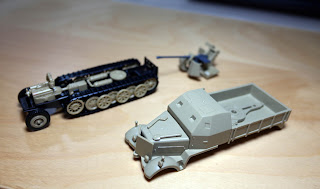The No. 1 version is supplied with a canvas tilt.
The No. 2 version comes with a sprue of supports for a canvas tilt.
The upper and lower hulls come attached to each other, but prying them apart will make the assembly process easier. The models go together very quickly, and look as good as diecast DUKWs.
 |
| Altaya vs 4D |
The Altaya model uses the same mold as the Russian Tank Collection model.
 |
| Amercom vs 4D |
The rudder is attached through a clipping mechanism that allows it to rotate.
The rope boat fenders are not textured in any way, but the models are still very nice, and ready for a load of cargo.
Comparison of the 4D DUKW with Altaya, Russian Tank Collection, and Amercom DUKWs.
The second model is a 3.7cm Flak 37 Sd.Kfz. 7/2 (八吨半履带防空裝甲车; 8-ton half-tracked armored anti-aircraft vehicle). I ended up with a model in tan plastic, but there is also one molded in gray plastic.
The undercarriage and front wheels are made of ABS plastic, but I think the rest of the sprues are polystyrene.
The seller included a handwritten note indicating that the parts on the sprue were fragile, but I didn't find that to be the case. Some of the parts on the A sprue are definitely small, but they are thick and robust.
I believe that polystyrene is weaker than ABS, so there is more of a possibility of breakage if force is applied when attaching the parts, but my recommendation is that if a part does not fit, file down the attachment pin until it fits, then glue it in place.
Assembly is not particularly complicated, but there is definitely an order that needs to be followed to make things easy.
Assembly of the undercarriage and wheels is essentially the same as for their earlier Sd.Kfz. 7.
The interior of the cab should be assembled first. The instructions are a bit messed up because it shows part C5 being installed upside down.
The armored cabin should be added next, hiding all of the interior detail that was just assembled.
The bonnet should be attached last, but the fit is not too good, and a significant gap is left between the cabin and the bonnet.
Parts of the Flak 37 are painted gray, but will need touch-up after being cut from the sprue. The parts also have a lot of awful ejector pin marks, but I didn't bother removing most of them because of the toy-like nature of this model.
Attach the Flak 37 to the base only after the upper and lower hulls are put together. The gun doesn't fit very tightly, but I don't think it's a major issue.
The side panels of the bed are molded in an upright position, so the Flak 37 is not really able to pivot, but the barrel can be raised and lowered.
The model is very similar to the previous 4D Sd.Kfz. 7, but it has separate lights and bumper guides, which (despite their chunky appearance) improve the look of the model.
The model is very similar to the previous 4D Sd.Kfz. 7, but it has separate lights and bumper guides, which (despite their chunky appearance) improve the look of the model.
Two other new 4D models that I didn't get are the 9A52-2 Smerch-M and the Sd.Kfz. 251/1 Ausf. C Wurfrahmen 40.
Pictures of the sprues for the Smerch-M can be found at moxing.net and bilibili, but I didn't really find anything on the Wurfrahmen 40.



































































